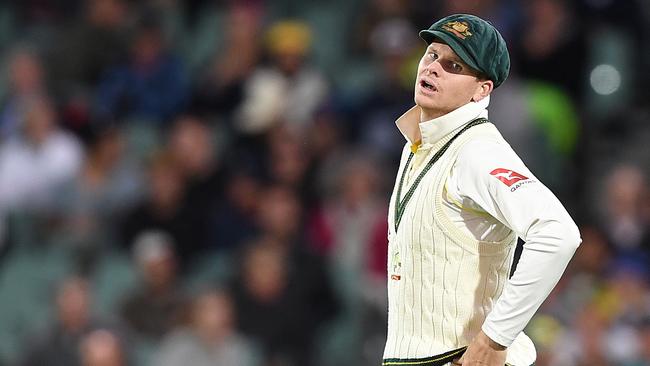England give Smith more nightmares in Adelaide
The Australian skipper, already under fire over his follow-on call, made a series of blunders that have given Joe Root’s England a sniff of victory.

Regrets, they’ll have a few, for rarely have decisions not involving player or shot selection weighed so heavily on the course of a Test and the reputations of those involved.
A game that began with furious debate over Joe Root’s call to send Australia in after winning the toss, closes with a similar row over Steve Smith’s refusal to enforce the follow-on when the fourth evening was spread against the sky.
How fitting the symmetry of England 4-176 at stumps, exactly 176 short of victory. The England captain is 67 not out which, combined with James Anderson’s first five-wicket haul in this country, have been crucial contributions to the visitors’ change of fortune.
Australia’s bowling coach David Saker said the Australians were “still reasonably confident” last night. “Obviously the last two days haven’t gone to plan, but I still think we’re in front of the game,” Saker said. “But it’s getting closer and closer and Joe’s innings has made that possible. If we get his wicket in the morning I think the game changes quite quickly.”
Saker said the Australian bowlers didn’t swing the ball as much as their opponents in part because they hadn’t “had the luxury of having a new ball late on days — where England have”.
Asked if there was any regret about handing England the opportunity of bowling in perfect conditions in the last session on day three, Saker said: “In hindsight it probably is, yeah.”
Mitchell Starc said in the nervous aftermath of England’s Monday evening rampage that it was Smith’s call not to enforce the follow-on, then went on to point out that despite having lost the top four batsmen for next to nothing there were six survivors who could make the most of good batting conditions yesterday.
Well, they didn’t and it was England’s top order who got the best of the going when they should have got the worst. What was left of Australia’s order proceeded so cavalierly yesterday you would have thought the lead was 500 and not bubbling about 200 shy of that.
Whose error was the greatest? Is Root absolved by the twists and turns of fate or is Smith?
John Maynard Keynes observed it is “better for the reputation to fail conventionally than succeed unconventionally”. Michael Clarke faced little criticism for electing to bat when his side posted 60 at Edgbaston because it was the conservative course, but many a captain has suffered for taking the road less travelled when the opposition has profited.
And then there was the DRS. Yesterday, Smith opted not to call review an lbw decision despite Josh Hazlewood jazz handing it all the way into a buckled-knee plea. For all the world it appeared the ball was jagging down legside and so there was little surprise when the skipper didn’t ask for a review — at least not until the ball tracker revealed a trajectory into Alastair Cook’s leg stump.
With that knowledge, revisions of Smith’s indecision were swift and to a degree salient. Under the new laws the side does not lose a review if it is deemed umpire’s call.
J. Alfred Prufrock spoke of “time for a hundred indecisions, and for a hundred visions and revisions, before the taking of toast and tea”. Smith is unlikely to have studied the works of TS Eliot or Keynes but he may find some sympathy with the character who had seen his “head brought in on a platter” had Cook gone on to a bigger score. He only added 14 more runs after the reprieve.
That unreviewed delivery appeared to be missing leg to most informed observers will be of little comfort to Smith, but adds further fuel to the questioning of the predictive element of the technology in this match.
After the taking of dinner Smith squandered both Australia’s reviews in the space of three balls. It hasn’t hurt him yet, but indeed there is time, and teams no longer get a top-up at 80 overs.
Twice in Australia’s innings lbw decisions against Shaun Marsh and Tim Paine were shown to have a something of a pole vaulter’s trajectory, clearing the stumps by some distance.
You could forgive the officials for getting rattled but it was hard to see why Chris Gaffaney didn’t give Cook a little later. Then again, Nathan Lyon appeared to indicate the ball may have been drifting down leg. Smith challenged the moment and its momentum and was proved right. The ball was crashing into leg stump.
Lyon is the leading wicket-taker in the world this year. Cook’s scalp took him to 56 wickets from nine matches at an average of 22.
Peter Handscomb is an area of concern. He came into this game with an average of 50 but with a technique that appears to be on course for disaster. He has batted deep in the crease for some time now but his spread-legged stance has got itself to a place where he is incapable of coming forward.
Handscomb has scores of 14, 36 and 12 in the series. It’s barely indicative of a major problem and the anxiety of observers may prove to be part of that long-held intolerance for anybody with a contrary approach.






To join the conversation, please log in. Don't have an account? Register
Join the conversation, you are commenting as Logout